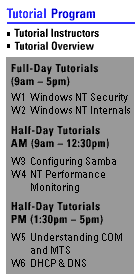



Jamie Hanrahan, Kernel Mode Systems
Who should attend: Windows applications developers and system administrators who need to understand the internal behavior and structure of Windows NT.
Take better advantage of Windows NT, both versions 4 and 5, by learning its underlying internal architecture & operation. Learn how to work with and take full advantage of NT features such as asynchronous I/O, preemptive multitasking, and multiprocessor support. Windows NT is a new operating system base, and is not built on the old DOS/Win16 platform, so "Designed for Windows 95" does not guarantee "runs on Windows NT!" This tutorial will help you ensure application compatibility between all Windows versions and NT.
Topics covered include:
|
|
General system architecture
|
|
|
Calling system functions from applications
|
|
|
Environment subsystems
|
|
|
Thread scheduling
|
|
|
Memory management internals
|
|
|
Using and interpreting performance measurement tools
|
|
|
Windows 9x/NT application compatibility checklist
|
Jamie Hanrahan provides Windows NT driver development, consulting, and training services to leading companies. He received the Instructor of the Year award while teaching courses for Digital Equipment Corporation. He is co-author of VMS Advanced Driver Techniques. He is co-writing a book on Windows NT device drivers to be published by O'Reilly and Associates.

